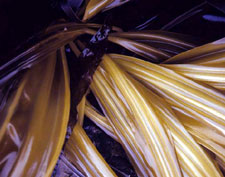

|
Seaweed: Ochrophyta
 All brown algae belong to the Class Phaeophyceae , Phylum Ochrophyta. This phylum name comes from the two different types of flagella borne by swimming cells of its members. The forward directed flagellum bears stiff tubular hairs called mastigonemes and is longer than the smooth, backward-directed flagellum. An eyespot, when present, occurs near the flagellar swelling at the base of the backward directed flagellum, and allows the cell to respond to light. All brown algae belong to the Class Phaeophyceae , Phylum Ochrophyta. This phylum name comes from the two different types of flagella borne by swimming cells of its members. The forward directed flagellum bears stiff tubular hairs called mastigonemes and is longer than the smooth, backward-directed flagellum. An eyespot, when present, occurs near the flagellar swelling at the base of the backward directed flagellum, and allows the cell to respond to light.The chloroplast is surrounded by three membranes: the double membrane of the chloroplast envelope, and the chloroplast endoplasmic reticulum, which is often continuous with the nuclear envelope. Thylakoids within the chloroplast are stacked in groups of three, and the primary pigments are chlorophylls a, c1 and c2. The main storage product of photosynthesis is chrysolaminarin,a  -1,3-linked polymer of glucose; it is stored outside the chloroplast in a special vacuole. -1,3-linked polymer of glucose; it is stored outside the chloroplast in a special vacuole. All brown algae are multicellular. The only flagellated cells are reproductive cells (there are no free-living flagellated unicells in the Class Phaeophyceae), and the flagella are inserted laterally. Brown algal chloroplasts are usually golden brown in color because of the accessory pigment fucoxanthin. Cell walls are composed of a fibrillar cellulose network and an alginate mucilage. Almost all brown algal species are marine, and the largest and most morphologically complex marine algae are brown algae. * taxon has a detailed description of its life history
|







